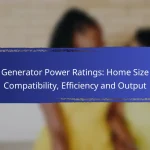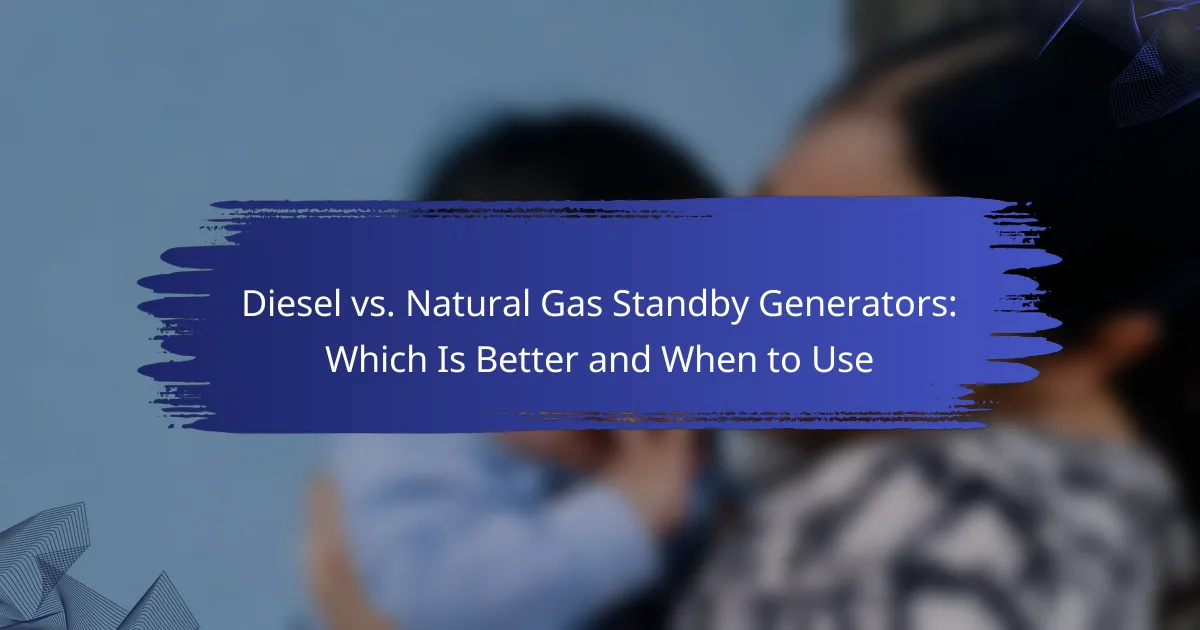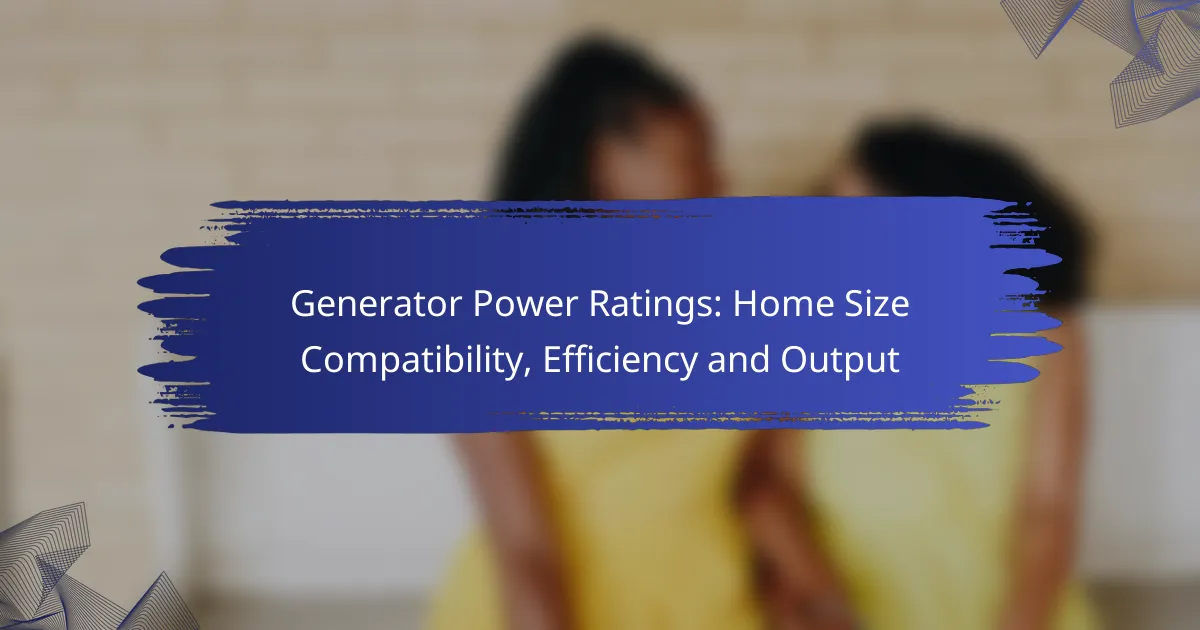Standby generators are essential for urban homes, providing reliable power during outages while balancing power output, noise levels, and space efficiency. With various options available, including portable, inverter, and dual-fuel generators, homeowners can find a solution that meets their specific needs and preferences. Choosing the right generator involves assessing power requirements, noise considerations, and local regulations to ensure a suitable and compliant installation.

What types of standby generators are best for urban homes?
For urban homes, the best standby generators are those that balance power output, noise levels, and space efficiency. Options like portable, inverter, stationary, dual-fuel, and solar-powered generators cater to various needs and preferences.
Portable generators
Portable generators are versatile and easy to move, making them ideal for temporary power needs. They typically run on gasoline and provide sufficient wattage for essential appliances during outages.
When selecting a portable generator, consider its power output, fuel efficiency, and noise level. Models with a noise rating below 60 dB are preferable for urban settings to minimize disturbance.
Inverter generators
Inverter generators are known for their quiet operation and clean power output, making them suitable for sensitive electronics. They convert raw power into a stable current, which is essential for devices like computers and televisions.
These generators are generally more compact and lightweight than traditional models, making them easier to store in urban homes. Look for models with a power output of 1,000 to 3,000 watts for typical household needs.
Stationary generators
Stationary generators are permanently installed and automatically kick in during power outages, providing seamless backup power. They usually run on natural gas or propane, which is convenient for urban homes with gas lines.
Consider the generator’s capacity, typically ranging from 7,000 to 20,000 watts, depending on your home’s power requirements. Ensure it complies with local regulations and zoning laws regarding installation.
Dual-fuel generators
Dual-fuel generators can operate on both gasoline and propane, offering flexibility and convenience. This feature is particularly useful in urban areas where fuel availability may vary.
When choosing a dual-fuel generator, assess its wattage output and fuel consumption rates. Models that switch between fuel types easily can provide peace of mind during extended outages.
Solar-powered generators
Solar-powered generators utilize solar panels to harness energy from the sun, making them an eco-friendly option for urban homes. They are quiet and require minimal maintenance, appealing to environmentally conscious consumers.
These generators are best for smaller power needs, often providing enough energy for lights and small appliances. Consider investing in battery storage systems to maximize their effectiveness during cloudy days or nighttime use.

How do I choose the right standby generator for my urban home?
Choosing the right standby generator for your urban home involves assessing your power needs, considering noise levels, evaluating fuel options, and checking local regulations. Each of these factors will help ensure you select a generator that meets your requirements without disturbing your neighbors or violating any laws.
Assess power needs
Start by determining the total wattage required to power essential appliances during an outage. Common household items like refrigerators, heating systems, and lighting can add up to several thousand watts. A good rule of thumb is to calculate your peak load and then add a buffer of around 20-30% to ensure the generator can handle surges.
For example, if your essential appliances total 5,000 watts, you should consider a generator rated for at least 6,000 to 7,000 watts. This will provide enough capacity for any additional devices you may need to run.
Consider noise levels
Noise levels are a significant concern in urban settings, where generators can disturb neighbors. Look for models that operate at lower decibel levels, ideally below 60 dB, which is comparable to normal conversation. Many manufacturers provide noise ratings, so check these specifications before making a decision.
Additionally, consider installing soundproof enclosures or placing the generator away from living areas to minimize noise impact. This can help maintain a peaceful environment while ensuring you have backup power.
Evaluate fuel options
Standby generators typically run on natural gas, propane, or diesel. Natural gas is often the most convenient and cost-effective option for urban homes, as it connects directly to your home’s gas line. Propane offers flexibility and portability, while diesel is usually more efficient but may require more maintenance.
Consider the availability of fuel in your area and the associated costs. For instance, natural gas prices can fluctuate, so it’s wise to evaluate long-term fuel expenses when making your choice.
Check local regulations
Before purchasing a standby generator, review local regulations regarding installation and operation. Many urban areas have specific noise ordinances and zoning laws that dictate where generators can be placed and how loud they can operate.
Consult with your local building authority or homeowners’ association to ensure compliance. This step can prevent potential fines and ensure a smoother installation process.

What are the benefits of standby generators for urban living?
Standby generators provide reliable power solutions for urban homes, ensuring that essential appliances remain operational during outages. They offer convenience, safety, and potential increases in property value, making them a valuable investment for city dwellers.
Continuous power supply
Standby generators automatically activate during power interruptions, providing a continuous power supply to your home. This means that critical systems such as heating, cooling, and refrigeration remain functional, preventing food spoilage and maintaining comfort.
Most standby generators can supply power for hours or even days, depending on the fuel source and tank size. For urban homes, a generator with a capacity of 7,000 to 20,000 watts is typically sufficient to cover essential circuits.
Increased property value
Installing a standby generator can enhance your home’s marketability and increase its overall value. Potential buyers often view homes with backup power systems as more desirable, especially in areas prone to outages.
In urban settings, where power reliability can fluctuate, having a generator can set your property apart. This added feature may lead to a higher selling price, often recouping a significant portion of the installation cost.
Enhanced safety during outages
Standby generators improve safety during power outages by ensuring that security systems, lighting, and emergency equipment remain operational. This is particularly important in urban areas where crime rates may rise during blackouts.
Moreover, a reliable power source can prevent dangerous situations caused by loss of heating or cooling, which is vital in extreme weather conditions. Homeowners should consider generators that comply with local safety regulations to ensure proper installation and operation.

What are the installation requirements for standby generators in urban areas?
Standby generators in urban areas must meet specific installation requirements to ensure safety, compliance, and efficiency. These requirements typically include considerations for space, local permitting, and professional installation to adhere to municipal regulations.
Space considerations
When installing a standby generator in an urban setting, space is a critical factor. Generators should be placed at least 5 feet away from structures and openings to prevent carbon monoxide buildup. Additionally, consider noise levels; many cities have regulations limiting noise emissions, so selecting a quieter model may be necessary.
Homeowners should also assess their property layout to determine the best location for the generator. This may involve evaluating access for maintenance and fuel delivery, ensuring that the generator is easily reachable without obstructing pathways or driveways.
Permitting and zoning
Before installation, it’s essential to check local zoning laws and permitting requirements for standby generators. Many urban areas require permits to ensure compliance with safety and environmental standards. Homeowners should contact their local building department to understand the specific regulations applicable to their neighborhood.
Some municipalities may have restrictions on generator placement, such as prohibiting installation in front yards or near property lines. Understanding these regulations upfront can help avoid costly modifications or fines later on.
Professional installation
Hiring a licensed electrician or generator specialist for installation is crucial in urban areas. Professionals ensure that the generator is correctly connected to the home’s electrical system and meets all local codes. This step is vital for safety and functionality, as improper installation can lead to hazardous situations.
Additionally, professional installers can help navigate the permitting process, ensuring all necessary approvals are obtained. This can save homeowners time and reduce the risk of non-compliance with local regulations.

How much do standby generators cost in urban markets?
Standby generators in urban markets typically range from a few thousand to over ten thousand USD, depending on capacity and features. Installation costs may add another 20-30% to the overall expense, influenced by local labor rates and regulations.
Factors Influencing Cost
The cost of standby generators is affected by several factors, including generator size, fuel type, and brand. Larger units that can power more appliances generally cost more. Additionally, diesel generators tend to be pricier than natural gas models due to fuel availability and efficiency.
Installation complexity also plays a role; urban homes may require additional permits or modifications to comply with local codes, which can increase costs. It’s essential to consult with a licensed electrician to understand specific requirements in your area.
Average Price Ranges
For residential standby generators, prices typically start around 2,000 USD for smaller units and can exceed 10,000 USD for larger, more powerful systems. Mid-range models, suitable for most urban homes, usually fall between 4,000 and 8,000 USD.
Consider ongoing maintenance costs as well, which can average 100-300 USD annually, depending on the service provider and the generator’s usage. Regular maintenance ensures reliability and longevity, making it a worthwhile investment.
Financing Options
Many homeowners explore financing options to manage the upfront costs of standby generators. Some manufacturers offer payment plans, while local utility companies may provide rebates or incentives for purchasing energy-efficient models.
Additionally, consider home improvement loans or personal loans, which can help spread the cost over time. Always compare interest rates and terms to find the best financing solution for your budget.










